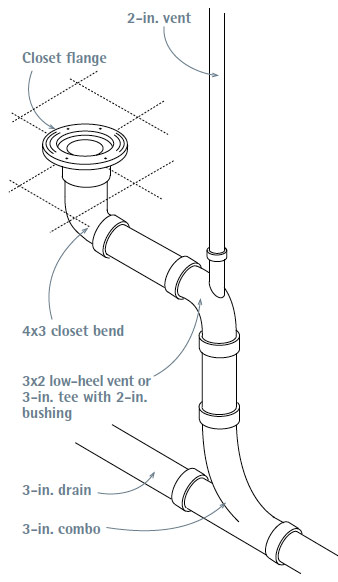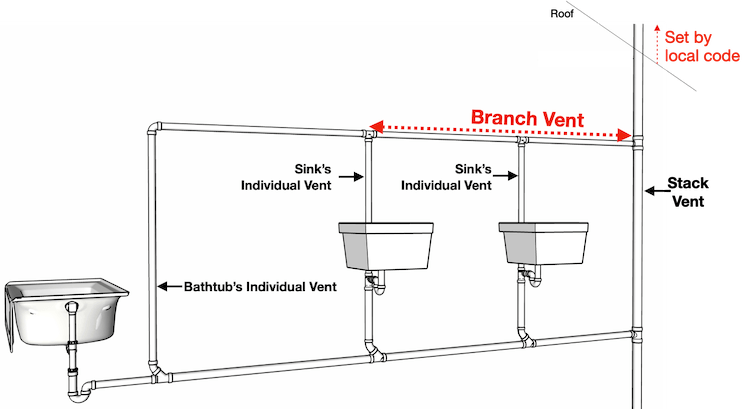Achieving Correct Ventilation in Your Plumbing System: How
Achieving Correct Ventilation in Your Plumbing System: How
Blog Article
Were you searching for related information on The Upsides of Proper Ventilation in Plumbing Design?

Correct air flow in plumbing systems is frequently neglected, yet it is critical for keeping the performance and safety of your home's plumbing. Air flow helps regulate atmospheric pressure, avoid the build-up of harmful gases, and make sure the reliable removal of waste. In this overview, we will certainly discover the significance of proper plumbing air flow, just how it functions, and the benefits it brings to your plumbing system.
Understanding Air Flow in Pipes
Air flow in plumbing refers to the network of pipelines that allow air to flow with the drainage system. These vents offer several functions, including controling atmospheric pressure within the pipelines, avoiding sewage system gases from getting in the home, and aiding in the smooth flow of wastewater.
Just How Ventilation Works in Plumbing Systems
Atmospheric Pressure Policy
Proper ventilation maintains well balanced air pressure within the pipes system. When water moves through pipelines, it displaces air. Without sufficient ventilation, this displacement can produce unfavorable pressure, leading to reduce drains pipes or siphoning of water from traps, which can create unpleasant odors to leak right into the home.
Stopping Sewer Gas Accumulation
Among one of the most essential functions of plumbing vents is to avoid sewer gases, such as methane and hydrogen sulfide, from building up within the home. These gases can present major wellness dangers and are extremely combustible. Vent pipelines allow these gases to escape securely outside.
Assisting in Waste Elimination
Air flow assists in the effective removal of wastewater by preventing airlocks in the drainage system. When air can stream openly via the vents, it permits water and waste to move smoothly through the pipes, minimizing the risk of clogs and backups.
Kinds Of Pipes Vents
Key Heap Vent
The primary stack air vent, also called the air vent pile, is the key air vent in a plumbing system. It prolongs from the main drainpipe align with the roofing system, allowing gases to run away and fresh air to go into the system.
Branch Vent
Branch vents connect to the main stack vent and serve specific fixtures, such as sinks, toilets, and showers. These vents ensure that each component has sufficient air flow to function effectively.
Air Admission Valve (AAV).
An Air Admission Shutoff (AAV) is a one-way valve that allows air to get in the pipes system without the need for a conventional vent pipe prolonging via the roofing. AAVs are commonly made use of in restorations or locations where mounting a typical vent is impractical.
Indicators of Poor Air Flow in Pipes.
Slow Draining Fixtures.
If your sinks, bathtubs, or bathrooms are draining pipes slowly, it could be an indication of bad ventilation. Inadequate air circulation can produce a vacuum result, making it tough for water to drain pipes properly.
Gurgling Appears.
Gurgling audios coming from drains are typically an outcome of air being drawn with water traps as a result of negative pressure in the pipelines. This is a clear indication of insufficient air flow.
Undesirable Odors.
Sewer odors inside your home are a red flag that your plumbing system is not effectively ventilated. This could mean that sewage system gases are not being effectively aired vent outside, bring about potentially harmful conditions.
Typical Air Flow Errors.
Poor Vent Sizing.
Utilizing small vent pipes can lead to poor air flow and pressure imbalances in the system. It's necessary to utilize vents that satisfy the certain requirements of your plumbing system.
Improper Vent Positioning.
Putting vents also much from the fixtures they offer can minimize their effectiveness. Correct placement ensures that air can stream openly and successfully via the system.
Ignoring Code Needs.
Building regulations provide particular standards for plumbing ventilation. Neglecting these codes can result in a system that falls short to work appropriately and may cause pricey fixings or health hazards.
Advantages of Appropriate Air Flow.
Boosted System Efficiency.
Correctly ventilated plumbing systems operate a lot more effectively, with less obstructions, faster draining pipes, and less strain on the pipes. This efficiency extends the lifespan of the pipes system.
Improved Air High Quality.
By stopping drain gases from entering your home, appropriate air flow contributes to better interior air high quality, making your living setting healthier and extra comfortable.
Avoiding Water Damage.
Appropriate ventilation helps avoid water from being siphoned out of traps, which can lead to sewer gases getting in the home and causing water damage with time.
Steps to Guarantee Correct Air Flow.
Consulting Plumbing Codes.
Constantly seek advice from local plumbing codes when making or modifying your plumbing system. These codes offer the essential guidelines for proper venting and guarantee your system fulfills security criteria.
Normal Inspection and Maintenance.
Routine assessments can aid determine prospective ventilation problems before they end up being major troubles. Upkeep jobs, such as cleaning up vent pipes and looking for clogs, are necessary for maintaining the system in good working order.
Expert Setup.
For brand-new setups or major adjustments, it's important to employ a professional plumber. They have the knowledge to make sure the air flow system is correctly made and set up according to code.
Conclusion.
Correct ventilation is a crucial part of any type of plumbing system, making sure that it operates effectively and securely. By recognizing the relevance of ventilation, acknowledging the indicators of inadequate ventilation, and taking steps to keep your system, you can avoid expensive problems and secure your home's air top quality.
4 Things You Should Know About Your Plumbing Vents
What Plumbing Vents Are
Also called a vent stack, a plumbing vent is a vertical pipe attached to your drain line that runs through your roof. The plumbing vent pipe, or plumbing air vent, removes gas and odors from your plumbing system and allows fresh air to enter the pipes, helping the water to flow out of the drain pipes.
What Plumbing Vents Do
Plumbing vents have two basic functions. One of which is to allow unpleasant smelling wastewater and sewer gasses to escape your plumbing system instead of entering your home. Plumbing vent pipes are typically located on roofs, away from windows, to ensure the fumes exit the home completely.
The other function of the plumbing vent is to move fresh air into your plumbing system. This helps move water through every plumbing fixture in your house, like toilets and sink drains. Think of the way in which you need to let a little air into the bottle as you pour soda in order to make the drink flow smoothly.
Different Types of Plumbing Vents
True vent: This is the most common vent option. In simplest terms, a true vent is a vertical pipe attached to your drain line that exits through the roof. They often function as the main vent that other fixtures can connect to. Re-vent pipe or auxiliary vent: Attached to the drain line near specific plumbing fixtures, re-vent pipes run up and over to connect to the main vent. Common vent: Two plumbing fixtures installed on opposite sides of a wall are typically tied into the vent stack using something known as a sanitary cross. Wet vent: This venting option operates as a drain pipe and a vent at the same time. Wet vent drainage systems drain water from one fixture while venting the air from another. Although they’ve been used for over 100 years, wet vent systems have only recently been added to the plumbing code in many areas. If you’re planning on installing one in a bathroom remodel, make sure you check your local code prior to construction. Loop vent: For free-standing fixtures like kitchen island sinks, loop vents are ideal. These vent pipes run under the floor, rise from the P-trap, and create a loop inside the cabinet sink. Air admittance valve: An AAV is a one-way mechanical valve typically installed at the site of the plumbing fixture. AAVs allow venting to occur without having to tie into a larger venting system. They’re ideal for venting fixtures where you aren’t able to easily connect to an existing vent system. Common Plumbing Vent Issues
Although vent pipes typically don’t have water flowing through them, they’re still subject to many typical plumbing issues. For example, clogs are one of the most common problems associated with sewer vent pipes. If your vent pipe gets clogged, all of your plumbing fixtures tied into the vent stack will be affected.
A sink with a slow drain that bubbles and gurgles or a strong sewage smell around your toilet are both indicators that your toilet vent pipe is clogged. Because most vent pipes exit through the roof, old leaves, twigs or even a bird’s nest could be clogging the pipe.
Clogs in your vent pipe system cause a buildup of negative pressure, meaning that water won’t be able to flow out of your home very well. It’s similar to putting your finger over the opening of a straw to trap water inside. When you remove your finger, the water is able to flow out of the straw.
If you suspect you have any blockage in your vent, make sure you have a professional come examine the situation. Left unchecked, a blocked air vent can lead to other costly repairs, like leaks and sediment buildup.
Under Pressure
Pipe vents are essential aspects of a home’s plumbing system. Owning a home means learning about all sorts of things you never put much thought into before. But by understanding as much as you can about the important systems of your home, you can keep those budgets intact and those anxiety levels low.
https://www.homeserve.com/en-us/blog/home-improvement/plumbing-vents/

We hope you enjoyed our post on Why Plumbing Air Vents Are Important. Thanks a ton for finding the time to browse our posting. Enjoyed reading our posting? Please quickly share it. Let others discover it. I take joy in your readership.
Click Here Report this page